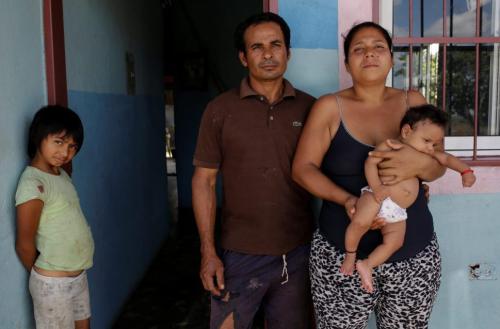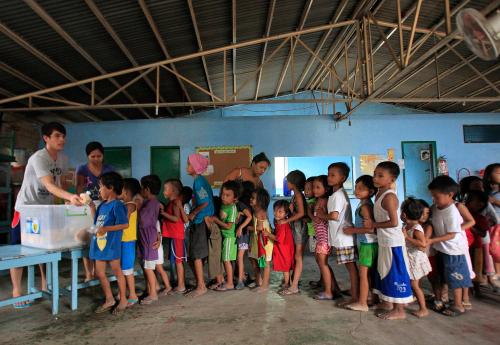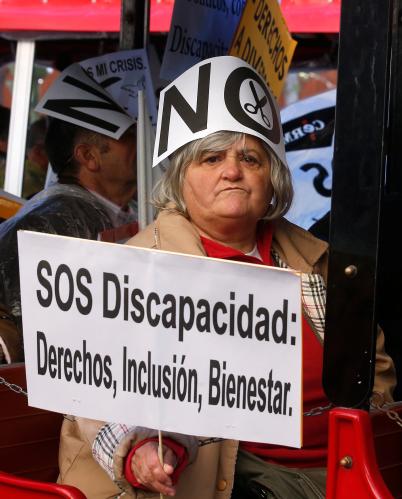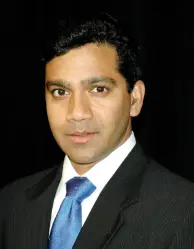Recently on Future Development, authors analyzed different arguments for and against universal basic income, including on the topics of how to better use oil revenues, universal versus targeted social programs, ending extreme poverty, providing basis needs, and boosting financial inclusion and transparency.
According to the International Labor Organization’s latest Social Protection Report, over 70 percent of the world’s population lacks adequate access to social protection. Meanwhile, efforts around the world to redesign social safety nets have revived the debate on targeting versus universalism. Universalism, of course, proposes that all citizens of a nation receive the same publicly provided benefits. By contrast, proponents of targeting argue for using various mechanisms to identify, and distribute the bulk of benefits to, the poor. In the 1970s and 1980s, many developing countries shifted away from broad social policies that emphasized universal benefits (but that often only covered a small fraction of the population) toward programs that required beneficiaries to meet specific criteria. But after years of emphasis on the need to target public resources to vulnerable segments of the population, the pendulum appears to be swinging back toward universalism. What does this imply for developing countries seeking to expand their systems of social protection?
The merits of universalism, for its defenders, are clear. First, there is the issue of accuracy, in that the information needed to identify accurately the poor is often complex and imprecise, with the poorest countries often lacking the statistical capacity to resolve these issues. Additionally, there is evidence that, because of the burdens placed on state administrations, universal benefits are sometimes cheaper than targeting. Some also argue that targeted programs create tensions between those who are excluded—some of whom may be among the poor but “missed” by targeting schemes—and the beneficiaries. Others have pointed out the tendency of politicians to abuse targeted programs by converting them into instruments of patronage. These are just few of the reasons why the Indian Ministry of Finance is considering a universal basic income, which, if implemented, would transform the system of social protection in a country that is home to over a third of the global poor.
In today’s advanced, industrialized nations, social protection did not typically involve an emphasis on targeting until well into the 20th century. In fact, modern welfare states were typically constructed with strong cross-class solidarity between urban, industrial workers, and the emerging middle class. Because the middle-class valued stability, its interests coincided with those of the working class; however, social protection was used to pacify the industrial workforce and more radical political movements such as socialist parties and revolutionary communes. In Germany between 1883 and 1889, largely with the support of “bourgeois” political parties opposing the social-democratic threat, Otto von Bismarck’s government enacted healthcare (1883), accident insurance (1884), unemployment, and old age pensions (1889) programs. Similarly, France established free medical assistance and programs for the elderly in the 1890s. Facing trade union mobilization and electoral threats from the newly formed Labour Party, the governing Liberals in Britain created worker pensions, unemployment, and health insurance between 1906 and 1911. These were all de jure universal programs.
Should today’s developing nations adopt this approach? Because their informal sectors are larger, and because the presence of organized labor is weaker compared to richer countries, most developing nations are concerned about the ability of universal systems to cover a sufficient portion of the workforce. A review of the World Bank’s Atlas of Social Protection Indicators of Resilience and Equity data reveals the difficulty in building social protection systems with truly universal scope. Figure 1 shows the benefits and the coverage of two major components of social protection: (1) social assistance—cash transfers, in-kind provisions, subsidies, fee waivers, (non-contributory) pensions, and public works programs—and (2) social insurance, or old age, survivors’, and disability pensions, along with employment-related benefits. Social assistance consists of programs usually targeted at the poor that are non-contributory and are financed from general revenues, while social insurance are contributory, employment-related benefits. The Figure 1 shows average daily benefits (in purchasing power parity-adjusted dollars per capita) and coverage rates (as a percent of the eligible population) by income quintile. While coverage rates for social assistance are far more progressive than for social insurance, the benefits they provide are relatively paltry. Social insurance, on the other hand, provides greater benefits but remains regressive.
Figure 1 also shows the dilemma that social program designers face. Most of the “global” middle class, in these countries, are in the upper quintiles. Increasing social assistance—something that would benefit the poor more directly—can lead to middle-class discontent. In many low- and middle-income countries, the growing middle class has little stake in the system of social assistance from which they are excluded. In these countries, the middle class sends their children to private schools, use private health care, dig their own wells, and buy their own generators. That degree of middle-class exit means there are few demands to improve the public provision of services. On the other hand, should program designers move toward a universal system, the richer quintiles would inevitably capture a disproportionate share of benefits.
Figure 1: Distribution of social benefits and coverage
 Notes: Graphs show (unweighted) averages with 95 percent confidence intervals by income quintile (Q1 = poorest, Q5 = richest). Data is the most recently available for each country; generally from 2000-2015.
Notes: Graphs show (unweighted) averages with 95 percent confidence intervals by income quintile (Q1 = poorest, Q5 = richest). Data is the most recently available for each country; generally from 2000-2015.
Source: World Bank, ASPIRE database.
For low- and middle-income economies, the answer to this problem lies in relying on a mix of universal and targeted programs while, at the same time, utilizing innovations that improve social program efficiency.
In practice, this would mean, for example, changing eligibility rules for social insurance in order to cover a larger proportion of those in the lower quintiles and to include the self-employed and those in the informal sector, which would provide greater gains for the poorest through programs that the middle class support. It would also mean expanding the resources available to the poor through social assistance programs that convince the non-poor of the value of these programs. The political benefit of conditional cash transfers in Latin America and elsewhere—requiring beneficiaries to comply with certain requirements in order to be eligible to receive funds—was to counteract the belief that poor households will misuse income transfers.
Other technical solutions—such as identification systems that enable registries of potential beneficiaries to be updated and link to other databases (including the census, geospatial data, and land and housing cadasters) as well as mobile money technologies that lower administrative costs—would make delivering targeted and universal programs alike more efficient.







Commentary
Rethinking the universalism versus targeting debate
May 31, 2017